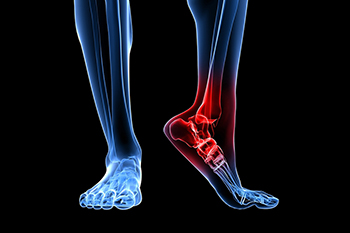Connect With Us
Blog
Items filtered by date: September 2024
Foot Exercises for Balance and Strength

Maintaining strong and balanced feet is essential for overall stability and mobility. One effective exercise is toe raises, which involves lifting your heels off the ground while standing on your toes to strengthen the calf muscles and improve balance. Another beneficial exercise is the toe and heel walk, where you walk on your toes for a few steps and then switch to walking on your heels. This helps enhance both strength and coordination. Foot doming is also useful. While sitting, try to create an arch in your foot by lifting the middle of the foot and keeping your toes and heel on the ground. Lastly, resistance band exercises like pulling the band with your toes while seated, can strengthen the foot’s intrinsic muscles. If you have sustained an injury due to weak foot muscles, it is suggested that you contact a podiatrist who can offer the correct treatment options.
Exercising your feet regularly with the proper foot wear is a great way to prevent injuries and build strength. If you have any concerns about your feet, contact one of our podiatrists from Crosstown Podiatry. Our doctors can provide the care you need to keep you pain-free and on your feet.
Exercise for Your Feet
Exercise for your feet can help you gain strength, mobility and flexibility in your feet. They say that strengthening your feet can be just as rewarding as strengthening another part of the body. Your feet are very important, and we often forget about them in our daily tasks. But it is because of our feet that are we able to get going and do what we need to. For those of us fortunate enough to not have any foot problems, it is an important gesture to take care of them to ensure good health in the long run.
Some foot health exercises can include ankle pumps, tip-toeing, toe rises, lifting off the floor doing reps and sets, and flexing the toes. It is best to speak with Our doctors to determine an appropriate regimen for your needs. Everyone’s needs and bodies are different, and the activities required to maintain strength in the feet vary from individual to individual.
Once you get into a routine of doing regular exercise, you may notice a difference in your feet and how strong they may become.
If you have any questions please feel free to contact our offices located in Wayne, Montclair, and Randolph, NJ . We offer the newest diagnostic and treatment technologies for all your foot and ankle needs.
What Leads to Heel Pain?

Heel pain can stem from various causes, leading to significant discomfort and disruption in daily activities. One of the most prevalent causes is plantar fasciitis, where inflammation of the tissue connecting your heel to your toes leads to sharp pain. Other possible culprits include heel spurs, which are bony growths that develop on the heel bone, and Achilles tendinitis, an inflammation of the tendon connecting your calf muscles to your heel. Complications from untreated heel pain include an altered gait, which might lead to additional strain on other joints and muscles, potentially causing further issues. Proper diagnosis is key to addressing the root cause of heel pain and preventing ongoing problems. If you are experiencing persistent heel pain, it is suggested you make an appointment with a podiatrist who can provide a comprehensive evaluation and recommend an effective treatment plan to relieve your symptoms.
Many people suffer from bouts of heel pain. For more information, contact one of our podiatrists of Crosstown Podiatry. Our doctors can provide the care you need to keep you pain-free and on your feet.
Causes of Heel Pain
Heel pain is often associated with plantar fasciitis. The plantar fascia is a band of tissues that extends along the bottom of the foot. A rip or tear in this ligament can cause inflammation of the tissue.
Achilles tendonitis is another cause of heel pain. Inflammation of the Achilles tendon will cause pain from fractures and muscle tearing. Lack of flexibility is also another symptom.
Heel spurs are another cause of pain. When the tissues of the plantar fascia undergo a great deal of stress, it can lead to ligament separation from the heel bone, causing heel spurs.
Why Might Heel Pain Occur?
- Wearing ill-fitting shoes
- Wearing non-supportive shoes
- Weight change
- Excessive running
Treatments
Heel pain should be treated as soon as possible for immediate results. Keeping your feet in a stress-free environment will help. If you suffer from Achilles tendonitis or plantar fasciitis, applying ice will reduce the swelling. Stretching before an exercise like running will help the muscles. Using all these tips will help make heel pain a condition of the past.
If you have any questions please contact our offices located in Wayne, Montclair, and Randolph, NJ . We offer the newest diagnostic and treatment technologies for all your foot and ankle needs.
Ingrown Toenails 101

An ingrown toenail occurs when the edge of a toenail grows into the surrounding skin, leading to pain, redness, and swelling. It commonly affects the big toe and can be caused by improper nail trimming, tight footwear, or genetic predisposition. Symptoms include sharp, throbbing pain, increased sensitivity, and, in more severe cases, infection with pus or drainage. Initial treatments for an ingrown toenail involve soaking the foot in warm, soapy water to reduce inflammation and pain. Mild pain relievers and antibiotic ointments can manage discomfort and prevent infection. Avoid cutting the nail yourself as improper trimming can worsen the condition. If symptoms persist or worsen, professional treatment from a podiatrist may be necessary. For a comprehensive evaluation and effective management of an ingrown toenail, it's suggested you make an appointment with a podiatrist.
Ingrown toenails can become painful if they are not treated properly. For more information about ingrown toenails, contact one of our podiatrists of Crosstown Podiatry. Our doctors can provide the care you need to keep you pain-free and on your feet.
Ingrown Toenails
Ingrown toenails occur when a toenail grows sideways into the bed of the nail, causing pain, swelling, and possibly infection.
Causes
- Bacterial infections
- Improper nail cutting such as cutting it too short or not straight across
- Trauma to the toe, such as stubbing, which causes the nail to grow back irregularly
- Ill-fitting shoes that bunch the toes too close together
- Genetic predisposition
Prevention
Because ingrown toenails are not something found outside of shoe-wearing cultures, going barefoot as often as possible will decrease the likeliness of developing ingrown toenails. Wearing proper fitting shoes and using proper cutting techniques will also help decrease your risk of developing ingrown toenails.
Treatment
Ingrown toenails are a very treatable foot condition. In minor cases, soaking the affected area in salt or antibacterial soaps will not only help with the ingrown nail itself, but also help prevent any infections from occurring. In more severe cases, surgery is an option. In either case, speaking to your podiatrist about this condition will help you get a better understanding of specific treatment options that are right for you.
If you have any questions please feel free to contact our offices located in Wayne, Montclair, and Randolph, NJ . We offer the newest diagnostic and treatment technologies for all your foot and ankle needs.
Dealing With Ankle Fractures

Ankle fractures occur when one or more bones in the ankle joint break, often due to a fall, twist, or sports injury. Symptoms include intense pain, swelling or bruising, and difficulty moving the ankle. Treatment for an ankle fracture depends on the severity of the break. For minor fractures, elevating the ankle is recommended, along with immobilization using a cast or splint. More severe fractures may require surgical intervention to realign the bones and secure them with pins, plates, or screws. After surgery or immobilization, exercises help restore strength and mobility. Follow-up care with a podiatrist ensures proper healing and helps prevent complications. If you experience ongoing pain after an injury or suspect an ankle fracture, it's suggested that you make an appointment with a podiatrist who specializes in diagnosing and treating foot problems and can guide you through the recovery process to ensure optimal healing.
Although ankle sprains are common, they aren’t always minor injuries. If you need your ankle injury looked at, contact one of our podiatrists from Crosstown Podiatry. Our doctors can provide the care you need to keep you pain-free and on your feet.
How Does an Ankle Sprain Occur?
Ankle sprains are the result of a tear in the ligaments within the ankle. These injuries may happen when you make a rapid shifting movement while your foot is planted. A less common way to sprain your ankle is when your ankle rolls inward while your foot turns outward.
What Are the Symptoms?
- Pain at the sight of the tear
- Bruising/Swelling
- Ankle area is tender to touch
- In severe cases, may hear/feel something tear
- Skin discoloration
Preventing a Sprain
- Wearing appropriate shoes for the occasion
- Stretching before exercises and sports
- Knowing your limits
Treatment of a Sprain
In many cases, the RICE method (Rest, Ice, Compression, and Elevate) is used to treat ankle sprains. However, you should see a podiatrist to see which treatment option would work best with your injury. In severe cases, surgery may be required.
It is important to ask your doctor about rehab options after you receive treatment for your injury. Stretching, strength training, and balance exercises may help the ankle heal while also preventing further injury.
If you have any questions, please feel free to contact our offices located in Wayne, Montclair, and Randolph, NJ . We offer the newest diagnostic and treatment technologies for all your foot care needs.

